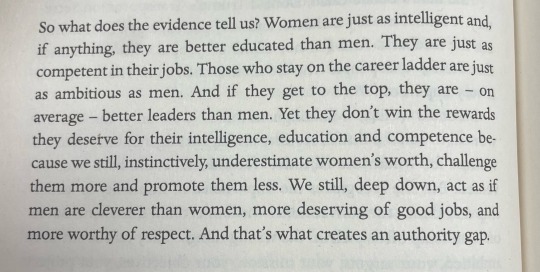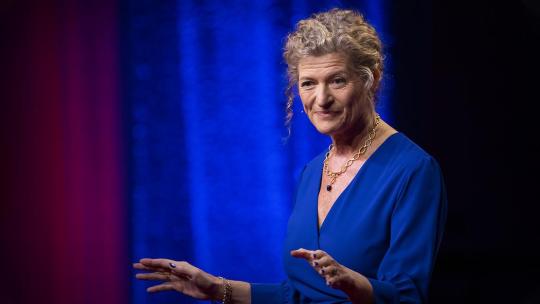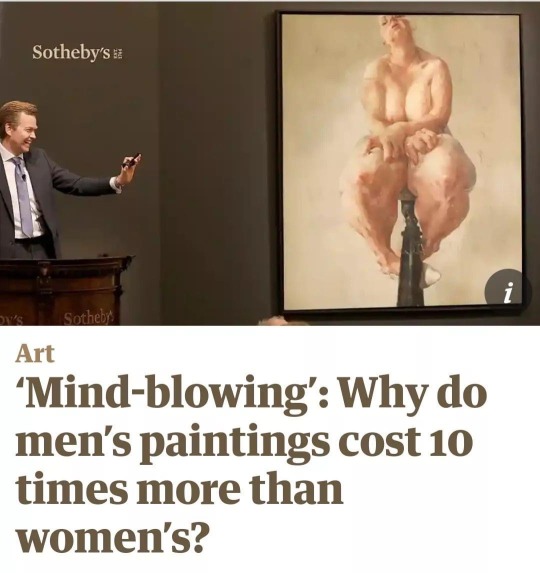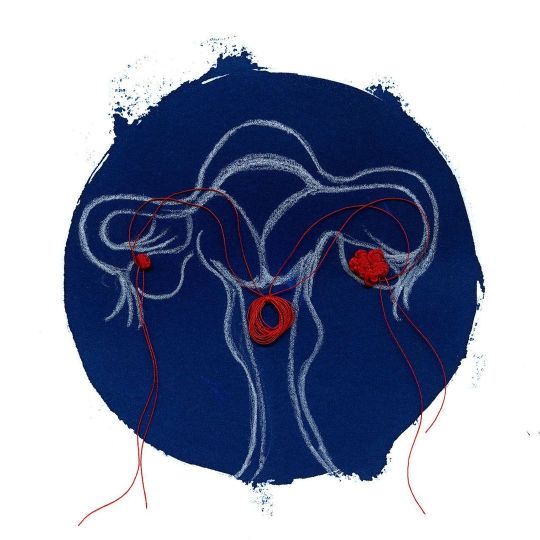#mary ann sieghart
Text
Men behave worse when they outnumber women. Put a woman alone in a meeting with four men, and 70 per cent of the interruptions she receives from men are negative. Turn it round so that you have four women and one man in the room: just 20 per cent of the interruptions women receive from men are negative. As the study says, when women predominate, 'Men undergo a drastic change. They become far less aggressive.'
Even very small boys - aged between three and a half and five - interrupt girls twice as often as the little girls interrupt them. Parents also interrupt daughters more often than sons, creating a pattern of behaviour in their children: the boys see that it is legitimate to interrupt girls and girls learn to expect it. This is setting children the example of the authority gap at such an impressionable age. It is iniquitous, but parents probably don't even realize they are doing it.
– Mary Ann Sieghart (2021) The Authority Gap: Why Women are Still Taken Less Seriously Than Men and What We Can Do About It, p. 63.
2K notes
·
View notes
Text
The Authority Gap: Why Women are Still Taken Less Seriously Than Men, and what We Can Do about it (Mary Ann Sieghart, 2021)
“‘I’ve known this for a very long time, that men just aren’t interested in reading our literature,’ Bernardine Evaristo told me.
‘So what does that say about our society? Our literature is one of the ways in which we explore narrative, we explore our ideas, we develop our intellect, our imagination.
If we’re writing women’s stories, we’re talking about the experiences of women. We also talk about male experiences from a female perspective.
And so if they’re not interested in that, I think that it says a lot and it’s very damning and it’s extremely worrying.
It seems to me that we’re seen as less important and more insignificant. And that is a big problem.’ (…)
‘I feel like I have no male readers. There’s something innately very patronizing about knowing that half the population considers my thoughts on anything to be completely irrelevant to them.
I do find that quite upsetting sometimes. On low days when I think about what that dismissal of my thoughts and stories and work is, it’s wounding.
It sends you into a weird existential place to think that half the population isn’t interested in what you’ve got to say.’
It’s not just that there is an authority gap: there is a complete void if men aren’t reading books by women. (…)
‘Affinity is a joyful thing,’ writes the novelist Anne Enright. ‘I have often admired the ease with which men praise books by other men, and envied, slightly, the way they sometimes got admired in their turn.
This spiral of male affection twists up through our cultural life, lifting male confidence and reputation as it goes.
Work by men is also read and discussed by female critics; only one side of the equation is weak: the lack of engagement with women’s work by men.’”
277 notes
·
View notes
Text
Mary Beard told me how she was once on a book prize panel, “and it was absolutely clear to me that the men picked really lengthy books. They would pick them up and say, ‘This is a really weighty contribution’ and what they meant was, ‘This is a very male contribution.’ Then one of the other judges said in the end, ‘We’re going to have some short books.’ It’s not that the contributions of men and women are colossally different, but the affirmative adjectives that are used to make us think that we can all agree about this candidate rather than the other one tend to be heavily correlated with male candidates. Women don’t do ‘weighty’ things. These are words that are not so glaringly correlated with gender, but they’re a code for gender. The men who use those words are as unaware as anybody of that.” We all know instinctively that “heavyweight” is code for “male.”
Mary Ann Sieghart, Why Are So Many Men Still Resistant to Reading Women?
17 notes
·
View notes
Text

I cannot say enough that this book (The Authority Gap by Mary Ann Sieghart) is one of the most brilliant and jaw dropping thesis’ I have ever read. Ms. Sieghart wastes no time getting into the nitty-gritty of it, even the introduction holds no punches. She’s concise, efficient, and incredibly intelligent, which show’s prominently in her book.
I can’t recommend it enough.
#darkest academia#dark academia#academia#books#literature#bookish#chaotic academia#book recommendations#book reccs#thesis#nonfiction#please read this book#sexism#the authority gap#Mary Ann Sieghart#gender inequality#gender gap
3 notes
·
View notes
Text
“But it’s not women we need to fix, right? It’s how we all perceive and react to and interact with women.”
— Mary Ann Sieghart
1 note
·
View note
Quote
All my books were discussing quite big issues, but the blurbs were, ‘So and so has a job but can she find a boyfriend?’” Mackesy had no say in how her books were marketed, until she had a brainwave. She decided to change her name to the gender-neutral Alex Marwood and start again. “I know stacks and stacks of very nice men who aren’t at all prejudiced against women, but they just automatically think they won’t have anything in common with a book by ‘Serena.’” Her first thriller as “Alex,” The Wicked Girls, was widely reviewed, praised by Stephen King as one of his top ten books of the year, and won the prestigious Edgar Award for Best Paperback Original. She hasn’t looked back.
“It’s very clear from my Amazon reviews that my readership is much more male. And I’m about 50:50 in my following on social media, whereas before it was entirely women and the men that I knew. It changed everything for me having a new name.” One one-star review on Amazon, though, said, “I do not like thrillers from female authors. I would never have bought this book if I had known that Alex Marwood was a made-up name for a British female writer.” She has it up on her bathroom wall.
Why Are So Many Men Still Resistant to Reading Women?
Mary Ann Sieghart Considers the Literary Gender Gap
32 notes
·
View notes
Text

Why are women still taken less seriously than men? | Mary Ann Sieghart http://dlvr.it/T3pZwb
0 notes
Text
Why are women still taken less seriously than men? | Mary Ann Sieghart
https://www.ted.com/talks/mary_ann_sieghart_why_are_women_still_taken_less_seriously_than_men?rss=172BB350-0205&utm_source=dlvr.it&utm_medium=tumblr
0 notes
Text

Let's read this again - When I'm asked why do I host @art.by.women_women.in.arts channel, well this is why!
@poli_pal aka #PalianShow
- Women were dropped by galleries on becoming pregnant. Buying their work was seen as risky as they wouldn’t be as committed to their careers
- For some time, women have made up 70% of students in art college, selected on merit, and the art world prides itself on its liberal, progressive values. Yet it presides over the biggest pay gap I can think of.
-'For every £1 fetched by a male artist’s work, one by a woman gets a mere 10p – and its value plummets further if she signs it.
let's read it together:
‘Mind-blowing’: Why do men’s paintings cost 10 times more than women’s?
by Mary Ann Sieghart (2 Aug 22)
www.theguardian.com/artanddesign/2022/aug/02/painting-gender-pay-gap-recalculating-art
Are men 10 times better at painting than women? You might think so if you listened to the German artist xx , who famously told the Guardian in 2015 that “women don’t paint very well. It’s a fact. The market doesn’t lie.”
Helen Gorrill, the author of Women Can’t Paint, has studied the prices of 5,000 paintings sold all over the world and found that for every £1 a male artist earns for his work, a woman earns a mere 10p.
“It’s the most shocking gender value gap that I’ve come across in any industry at all,” she told me for a BBC Radio 4 documentary, Recalculating Art.
artwork: Jenny Saville $12.5m.
#womensart #artbywomen #GreatWomenPainters #ContemporaryArt #ArtMarket #artworld #art #painter #visualart #buyartbywomen
1 note
·
View note
Text
A real-life law change in India provided a wonderful control experiment for researchers: in 1993, the Indian government passed a constitutional amendment to address the dearth of female leaders in local politics. In each five-year election cycle, one their of villages were randomly selected to appoint a female pradhan or chief.
The result? After two cycles of having a female pradhan in a village, perceptions of women in leadership improved among both male and female villagers. What is more, parents' aspirations for their daughters increased: they were 45 per cent more likely to want their girls to progress beyond secondary school than parents in villages that had never had a female leader. Meanwhile, the girls themselves had greater ambitions, did better at school and shared household chores more equally with their brothers.
– Mary Ann Sieghart (2021) The Authority Gap: Why Women are Still Taken Less Seriously Than Men and What We Can Do About It, p. 306.
#mary ann sieghart#the authority gap#feminism#radical feminism#india#leadership#girlhood#politics#lilac posts
372 notes
·
View notes
Text
The Authority Gap: Why Women are Still Taken Less Seriously Than Men, and what We Can Do about it (Mary Ann Sieghart, 2021)
“Men behave worse when they outnumber women. Put a woman alone in a meeting with four men, and 70 per cent of the interruptions she receives from men are negative.
Turn it round so that you have four women and one man in the room: here, just 20 per cent of the interruptions women receive from men are negative.
As the study says, when women predominate, ‘Men undergo a drastic change. They become far less aggressive.’
Even very small boys – aged between three and a half and five – interrupt girls twice as often as the little girls interrupt them. (…)
Paula Stone Williams, a trans woman, married and had children before she transitioned.
‘I am learning a lot about what it means to be a female and I am learning a lot about my former gender,’ she says.
‘There is no way a well-educated white male can know how much the culture is tilted in his favour.
There’s no way he can understand it because it’s all he’s ever known and all he ever will know. I never thought I had privilege, but I did.
‘Apparently, since I became a female, I have become stupid.
The more you’re treated as if you don’t know what you’re talking about, the more you begin to question whether or not you do in fact know what you’re talking about.
I now understand a woman’s tendency to doubt herself.’ (…)
And not being listened to can have serious implications for women’s mental health.
Anita Martin is a psychiatrist in the north of England, covering a population of 120,000, and she told me, ‘It comes up again and again for women when they’re depressed that they find it really difficult to be heard, really difficult to assert themselves.
Everyone needs agency in their life. If your learned experience is that you’re not listened to, that your opinions don’t matter, you think there’s no point my doing anything because nothing will change.
That’s the message that they’ve constantly had from society, that what they think doesn’t matter. We see that more in women than men.’”
136 notes
·
View notes
Text
The Authority Gap
This event was a presentation by Mary Ann Sieghart about her recently published book.
Biographies of Speaker and Respondents:
– Mary Ann Sieghart is an author, journalist and radio broadcaster/presenter. She was for many years assistant editor at The Times, writing inter alia on politics and social affairs. She has a weekly politics column in The Independent.
– Tanya Castell MBE has a broad…
View On WordPress
0 notes
Text
Support art by women

There’s a massive gender pay gap in the world of art valuation.
In fact, paintings by women sell for a tenth of the price as paintings by men, a new BBC Radio 4 documentary finds.
How much do women’s paintings cost vs. men’s paintings?
In “Recalculating Art,” journalist Mary Ann Sieghart explores how women’s art is “literally undervalued.” She interviews artist and author Helen Gorrill, who did an analysis of 5,000 paintings and found that paintings by men sell for ten times the price of what paintings by women sell for.
The most expensive painting ever bought was Salvator Mundi by Leonardo da Vinci, which sold for $450 million. But the most expensive painting by a woman sold for less than a tenth of that — a painting by Georgia O’Keefe, which sold for $44.4 million, according to The Guardian.
This 1-10 ratio still occurs with paintings from contemporary artists. “It’s the most shocking gender value gap that I’ve come across in any industry at all,” Gorrill said.
And what’s more, when a man signs his painting, the value of the painting goes up; when a women does, the value goes down.
Why the pay gap?
“The dice were loaded” against women artists, Frances Morris, director of Tate Modern, says in the documentary.
“Women artists have fared very poorly because there’s been an unconscious collusion between the marketplace, art history and the institutions,” Morris says. “And, of course, convention and history were framed by patriarchy.”
Sieghart cites the example of E.H. Gombrich’s “The Story of Art,” which is one of the bestselling art books of all time, but only briefly mentions one female artist.
The good news
The good news is museums and collectors are beginning to recognize and remedy this gap by buying more art pieces by women. Prices for art by women are “currently rising 29% faster than for art by men,” Sieghart writes in The Guardian.
“There’s still a very long way to go until female artists earn anything like the same as male ones,” the documentary concludes. “But at last we are moving in the right direction.”
0 notes
Photo

new mixed projects brewing & this piece will be in @centerphotographicart 8x10 exhibition & i am changing my currency to state “in uterus we trust” & believe in putting my money where my mouth is these days, so i am focusing on learning & acquiring more art by women especially when i read articles that state women continue a 10:1 disparity in prices between men & women artworks. according to Helen Gorrill, she “…found that for every £1 a male artist earns for his work, a woman earns a mere 10p.” talk about a shocking gender value gap! if interested the article is called “mind blowing: why do men’s paintings cost 10 times more than women’s” by mary ann sieghart #shelovesyou #shesaidred #mixedmedia #cyanotypes #photooftheday #mixedmediaphotography #dohashtagswork (at Oakland, California) https://www.instagram.com/p/ChQOODyprfM/?igshid=NGJjMDIxMWI=
0 notes
Text
Women’s Prize For Fiction announces 2022 shortlist

The Women’s Prize for Fiction, said to be the greatest celebration of women’s creativity, recently announces its 2022 shortlist. Now in its 27th year, the Prize honors outstanding, ambitious, original fiction written in English by women from anywhere in the world. This year’s shortlist incorporates a range of themes including belonging and identity; the power of nature; the burden of history; personal freedom; sisterhood; mental illness; ghosts; gender violence; and the opportunity for renewal. The novels also offer globe-spanning settings, from Antarctica to Montana, Cyprus to Trinidad.
The shortlist includes:
The Bread the Devil Knead by Lisa Allen-Agostini, Myriad Editions. Nationality: Trinidadian
The Sentence by Louise Erdrich, Corsair, Nationality: American
Sorrow and Bliss by Meg Mason, Weidenfeld & Nicolson, Nationality: New
Zealander
The Book of Form and Emptiness by Ruth Ozeki, Canongate Books, Nationality: American-Canadian
The Island of Missing Trees by Elif Shafak, Viking, Nationality: Turkish-British
Great Circle by Maggie Shipstead, Doubleday, Nationality: American
None of the selected authors have been previously shortlisted for the Prize. Elif Shafak has previously been longlisted twice (in 2008 and in 2013). She again features among the most prolific authors on the shortlist with 12 published books. Louise Erdrich with 23 published novels comes a close second.
This year’s shortlist has been selected by the Chair of Judges Mary Ann Sieghart and her judging panel – Lorraine Candy, award-winning journalist and editor; Dorothy Koomson, global bestselling novelist, journalist, and podcaster; Anita Sethi, award-winning author, and literary journalist; and Pandora Sykes, journalist, broadcaster and author.
Chair of judges and bestselling writer Mary Ann Sieghart says, “We were blessed with an extraordinarily high quality of submissions this year, which made whittling down the longlist from sixteen to six particularly difficult. But the shortlist contains a wonderfully diverse range of stories, subjects, settings, and authors, from the experience of a Native American woman in a haunted bookshop to an early female aviator in the Antarctic. One novel is narrated by a tree; another by a book. Some are laugh-out-loud funny, others tearful, and sometimes the two are combined in the same book. We judges have loved reading them all and we commend them to you as the best fiction written by women and published in the past year. Our only problem now will be to identify the winner out of these six brilliant novels.”
Susanna Clarke won the 2021 Women’s Prize for Fiction for her novel Piranesi while Hamnet by Maggie O'Farrell was the winner in the pandemic year 2020. Tayari Jones won the coveted award in 2019 for her novel An American Marriage.
The winner of the 2022 Women’s Prize for Fiction will be awarded on Wednesday 15 June 2022 at an evening awards ceremony in central London. She will receive an anonymously endowed cheque for GBP 30,000 (approximately Rs 29 lakh) and a limited-edition bronze figurine known as a ‘Bessie’, created and donated by the artist Grizel Niven.
Set up in 1996 to celebrate and promote fiction by women to the widest range of readers possible, the Women’s Prize for Fiction is awarded for the best full-length novel of the year written by a woman and published in the UK between 1 April 2021 and 31 March 2022. Any woman writing in English – whatever her nationality, country of residence, age, or novel’s subject matter – is eligible.
The Women’s Prize will be hosting a Virtual Shortlist Festival on Monday 23, Tuesday 24, and Wednesday 25 June, at 7 pm, featuring live Q&As with the shortlisted authors. These events will be hosted by Kate Mosse, founder-director of the Prize, and will present readings from well-known actors. Tickets can be bought via Eventbrite.
0 notes